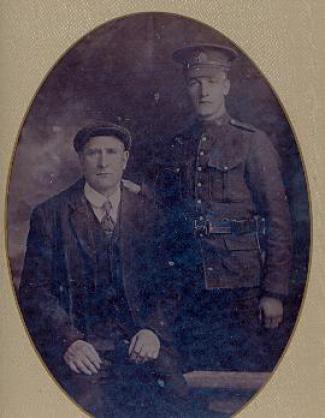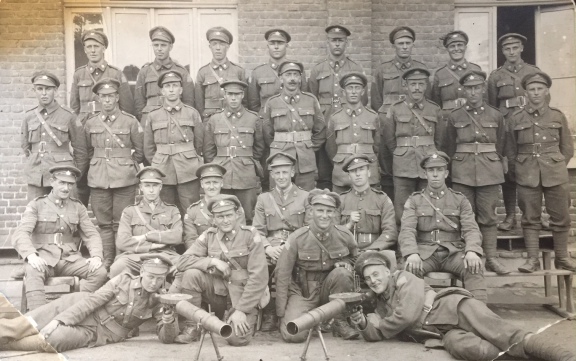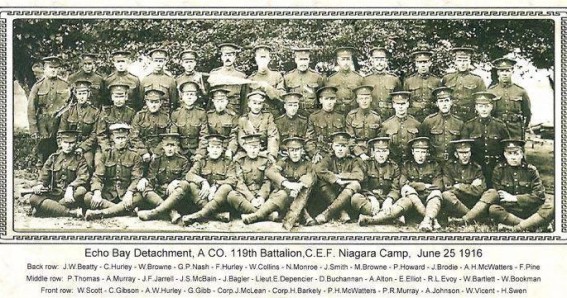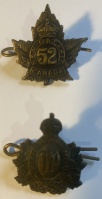
Remembering Art Hurley
Arthur Wilbert Hurley (uniform, standing) with his father, Charles Hurley. Below, with his army unit - he's back row, right end.
Below photo, A W Hurley, front row, third from left.
Art Hurley uniform pins from
New Ontario 52
and
Algoma 119 Battalion
https://vimyfoundation.ca/battles/passchendaele
In October 1917, my grandpa Art was a hero at the Battle of Passchendale, as detailed in his military highlights list following these descriptions of what it was like on the battlefield:
Veterans Canada describes it this way: "Advancing through the mud and enemy fire was slow and there were heavy losses but our soldiers clawed their way forward. On an exposed battlefield like that one, success was often only made possible due to acts of great individual heroism to get past spots of particularly stiff enemy resistance. Despite the adversity, the Canadians reached the outskirts of Passchendaele by the end of a second attack on October 30 during a driving rainstorm." More detail here:
http://www.veterans.gc.ca/eng/remembrance/history/first-world-war/fact_sheets/passchendaele
" The 3rd Division is to attack the Bellevue Spur on the north ridge and advance 1,200 metres toward Passchendaele. " My grandfather was at the Bellevue Spur.
Arthur Wilbert Hurley
Born Sept 18, 1897
Parents Charles A. Hurley b) Feb 19, 1865;
Sylvia (Crocker) Hurley b) April 2, 1876
Enlisted in Echo Bay Feb 7, 1916
Regimental number 754374
Left Halifax onboard SS Matagama Aug 8, 1916
Arrived in Liverpool, England Aug 19, 1916
Departed for Bramshott, England Dec 5, 1916
Transferred to 52 Battalion Dec 11, 1916
Arrived for duty Dec 31, 1916
Wounded June 8, 1917
Rejoined unit June 16, 1917
Assigned (?) Number 13,
Can Field Ambulance June 30, 1917
Event re: Military Medal September 3,4, 1917
Event re: second Military Medal October 26, 1917 (see date in Legion article below)
Wounded January 4, 1918
Awarded Military Medal1 January 13, 1918
Awarded Bar to Military Medal2 May 1, 1918
Appointed Lance Corporal May 5, 1918
Promoted to Corporal August 26, 1918
N.Y.D. (?) Gas August 27, 1918
Gassed August 28, 1918
Gassed (twice) September 1, 1918
Wounded September 2, 1918
Gassed September 3, 1918
Gassed September 7, 1918
Posted to medical facility Oct 5, 1918
Returned to Canada Jan 29, 1919
Appointed Light Keeper
at Pointe au Pins Dec 18, 1934
Turned 65 and was given Sept 18, 1961
Extension of service to March 31, 1962
Official retirement April 15, 1962
These entries from Appendix Number 1 to The War Diary of September 1917:
1Led a section of bombers in the attack on German position near Lens, night of September 3,4, 1917 attacking and capturing an enemy strong point.
Latter carried an important message under heavy fire and successfully delivered it.
The evening after the raid. Private Hurley volunteered to accompany an officer to recover the body of his company Commander, which owing to casualties, had not been brought in, and with the officer
after two unsuccessful attempts under heavy fire, found and brought in the body.
--
2Map Ref Belgium 28 N.E., D. 10. South of Passchendaele. Showed great coolness and gallantry throughout the operations against Bellevue Spur October 26, 1917. Observing an enemy patrol on No Man’s
land he located their position, went forward with a small party, opened fire on them inflicting casualties and captured the remainder of the party.
--
(parts of this entry is blurred/unable to be read; the volunteer referred to would be Art Hurley)
All casualties had to be brought back under heavy fire and the [can’t read] evacuation of all wounded speaks for itself. The [can’t read] and stretcher bearers was beyond praise and specific
instances are inopportune when all did so well. One case in connection with the bringing back of the dead and wounded will however illustrate the spirit that prevailed throughout. It was found that
after the operation was complete, that, owing to the party detailed for the purpose, having received additional casualties, one body, that of Capt. Fryor [possibly Fryer, or F could be G] the gallant
commander of “A” Company, had not been brought back but was left just outside CIBABAR [letters may not be these] trench. Lieut.. Graham [possibly Orenham; or, other variations] took one of the many
volunteers and at dusk the evening after the attack, proceeded to the enemy wire to complete the M.G. and rifle fire prevailing and found and brought back the body.
--
Subsequent research shows that this is likely the individual whose body was brought back (referenced as Capt. above and Major below; date of death and Unit correspond to event above):
Name: FRYER, HAL CHARLES
Initials: H C
Nationality: Canadian
Rank: Major
Regiment/Service: Canadian Infantry (Manitoba Regiment)
Unit Text: 52nd Bn.
Age: 22
Date of Death: 04/09/1917
Awards: M C, Mentioned in Despatches
Additional information: Son of Henry Benjamin and Anette Jane Fryer; husband of Agnes Pearl Malcolm Fryer, of 110, N. May St., Fort William, Ontario. Born at Fort William.
Casualty Type: Commonwealth War Dead
Grave/Memorial Reference: I. O. 24.
Cemetery: AIX-NOULETTE COMMUNAL CEMETERY EXTENSION
(Legion Magazine, May/June 2005) - The battle for the Belgian crossroads village of Passchendaele was one of the bloodiest battles of all time. In just 12 days—from Oct. 26 to Nov. 6, 1917—the
Canadian Corps suffered nearly 16,000 casualties, and all for a gain of 4 1/2 miles.
And so at dawn on Oct. 26, 20,000 men began inching their way across no man’s land in rain and mist, shell hole by muddy shell hole toward their objective.
Adding to the soldiers’ difficulties was the fact that German planes had managed to bomb and strafe the supply areas, reducing the capability of the artillery. But before the bloody battle was over on Nov. 6, nine Canadian Victoria Crosses had been earned, four of them on the same day, two of them posthumously.
Lieut. Robert Shankland had already been awarded the Distinguished Conduct Medal at Sanctuary Wood in 1916. Now, as an officer with the 43rd Bn., he distinguished
himself even further, enough to be awarded the VC. On the morning of Oct. 26, he led his platoon of 40 men from Company D to the crest of the hill at the Bellevue Spur, the main trench line defending
Passchendaele.
Overrunning it and holding the position was critical to capturing the town.
On the right, the 58th Bn., which was under heavy fire from Snipe Hill, was forced to retire after failing to reach its objective. Some of the men joined Shankland’s platoon, but this still left his
right flank open. For four hours they withstood incessant artillery shelling and German counterattacks, sustaining frightful casualties. But by this time, the 8th Brigade on the left was forced to
withdraw. This left both of Shankland’s flanks exposed.
He and his men were in danger of being cut off and losing the vital position gained at such fearful cost. The only solution was to bring up reinforcements and
counterattack. Shankland turned over his command to another officer and then weaved his way through heavy mud and German shelling to battalion headquarters where he gave a first-hand report of the
situation. He also offered a detailed plan on how a counterattack with reinforcements could best be achieved. He then returned to his men to lead the forthcoming attack supported by reinforcements
from the 52nd and 58th battalions.
A Co. of the 52nd, under the command of another Winnipegger, Christopher O’Kelly, was ordered to go to Shankland’s aid. O’Kelly’s troops worked their way to the crest of
the Bellevue Spur, where Shankland’s men were distracting the Germans with their fire. While sweeping the top of the hill in the face of enemy fire from pillboxes, O’Kelly’s men completely routed a
German column they caught advancing towards Shankland’s position.
O’Kelly then led his men against six pillboxes that were holding up the battalion’s advance. Under his aggressive leadership they overcame the concrete emplacements and
captured 100 Germans. Later that afternoon, O’Kelly and his men had to entrench themselves to ward off a German counterattack. But the day wasn’t over. That night, O’Kelly took his men out on a
sortie to capture an enemy raiding party. All told, in 18 hours his unit captured 284 prisoners and 21 machine-guns, a performance that earned him the VC, the third to be awarded in the Passchendaele
fighting.
--
Military Medal (MM)
Terms
The medal is awarded to Warrant Officers, non-commissioned officers and men for individual or associated acts of bravery on the recommendation of a Commander-in-Chief in the field.
Bar
The silver, laurelled bar is awarded for a subsequent act or acts of bravery and devotion under fire.
Description
A circular, silver medal, 1.42 inches in diameter.
Obverse
King George V: A bareheaded effigy, in Field Marshal's uniform, facing left, and the legend:
GEORGEIVS V BRITT: OMN: REX ET IND: IMP:
King George VI:A crowned effigy, facing left, and one of the legends:
(a) GEORGEIVS VI D: G: BR: OMN: REX ET INDIAE IMP: (for WWII)
(b) GEORGEIVS VI DEI GRA: BRITT: OMN: REX FID: DEF: *(for Korea)
Queen Elizabeth II: A crowned effigy, facing right, and the legend:
ELIZABETH II D: G: BR: OMN: REGINA R: D: (for Korea)
Reverse
The reverse shows FOR/BRAVERY/IN THE/FIELD in four lines, encircled by a laurel wreath and surmounted by the Royal Cypher and Imperial Crown.
Mounting
An ornate scroll suspender is attached to the medal with a single-toe claw.
Ribbon
A dark blue ribbon, 1.25 inches wide, with five equal centre stripes of white, red, white, red, and white (0.125" each).
Naming
The regimental or equivalent number, rank, initials, surname and unit of the recipient appear in plain block capitals around the edge of the medal.
Dates
The medal was instituted on 25 March 1916.
Issued
Canadians have received 13, 654 medals, plus 848 first bars and 38 second bars.




